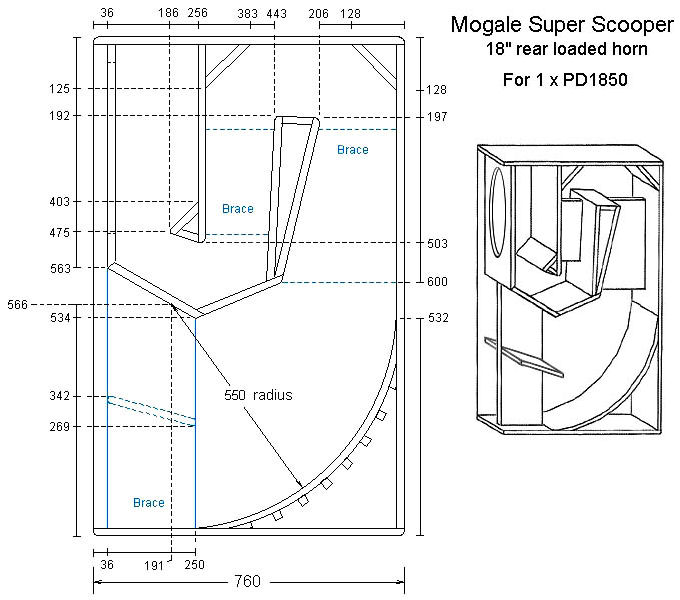Can anyone recommend a starting point for modelling this horn in Hornresp?
Speakerplans.com
I'm not sure where to start as it's been several year since I've used Hornresp and need a "leg-up"...
Thanks
Speakerplans.com
I'm not sure where to start as it's been several year since I've used Hornresp and need a "leg-up"...
Thanks
On speakerplans.com's own forum: Database simulation - Speakerplans.com Forums - Page 1
I've not bothered to check the accuracy, but it should get you at least in the ballpark.
I've not bothered to check the accuracy, but it should get you at least in the ballpark.
The curved bit at the bottom is counterprodcutive and would be easier and better with a straight approximation.
Yeah, the curve would be invisible to the low frequency sound waves though I wonder if it's an attempt reduce air turbulence and noise as it exits the horn?
On speakerplans.com's own forum: Database simulation - Speakerplans.com Forums - Page 1
I've not bothered to check the accuracy, but it should get you at least in the ballpark.
Thanks, I used to google to search the forum but didn't see that one. Ballpark is all I need at the moment. Once it's built I will measure properly.
Cheers
The curved bit at the bottom is counterprodcutive and would be easier and better with a straight approximation.
That's definitely a reduction of the resonances. Okay, you could fill the space with polyurethane foam but I've done that one time and I can promise I will NEVER do that huge mess again! I'd replace it with a 45° angle board which is reinforced with triangle plates. But you are right, acoustically, the straight edges would hardly harm the sound though.
Can anyone recommend a starting point for modelling this horn in Hornresp?
Speakerplans.com
I'm not sure where to start as it's been several year since I've used Hornresp and need a "leg-up"...
I'm not a hornresp veteran, though it's important to put the driver at the right distance of the horn length. At BLH the response can be vastly improved by an internal helmholtz absorber or by placing the driver not at the 'end' but a bit further into the length of the horn. Both instances are documented in several issues of the German DIY magazine 'Hobby Hifi'. I don't know the issue year/numbers though.
The curved bit at the bottom is counterprodcutive and would be easier and better with a straight approximation.
It would certainly be easier, but I am not sure that it would necessarily be better
The page linked below may be of interest, particularly the FEM simulation results shown:
Big BenD Bass Horn: Design
It would certainly be easier, but I am not sure that it would necessarily be better.
The page linked below may be of interest, particularly the FEM simulation results shown:
Big BenD Bass Horn: Design
I can promise you, the suggested change will not improve the subwoofer in any kind, form or shape. It's a half-a$$ed approach to make the build easier but doesn't have any positive approach on it. It is acceptable if you need an easier/much more simplified build of the scoop but leads to much more peaks and dips in the response because of the reflections within the horn, leading to interferences and resonances. If you want to use the upper range of the back loaded horn (which is the main purpose of a BL anyway) it's by far the worst thing you can do since it leads to a very 'wave-y' response with high peaks and dips. You can easily prove and forecast its very bad response in hornresp (software) or in AJHorn, it should be really avoided since you only get length resonances you have to deal with and get you very long decay ridges, which vastly muddy your bass up to your low mid range precision because of the phase difference. The impulse response in the upper bass/lower mids will also get squishy and boomy which results in having none advantage of the BL (scoop) horns.
BL horns are very delicate, It's not adviced to follow suggestions of inexperiecned 'read only' suggestions posters. You can get additional support on Speakerplans.com (register and ask) or other PA oriented pages. If you are aiming for high sound reproduction quality and not limited to Raggae or Dub, you're maybe better off with other subs anyway though.
That's definitely a reduction of the resonances. Okay, you could fill the space with polyurethane foam but I've done that one time and I can promise I will NEVER do that huge mess again! I'd replace it with a 45° angle board which is reinforced with triangle plates. But you are right, acoustically, the straight edges would hardly harm the sound though.
The one time I made a horn for a 12" woofer, I had no problems using PU foam.
I built it missing one side of the speaker, first I glued in place a piece of some kind of flexible flooring on the bends, gently misted the inside with some water, filled the gap with foam, cut off the excess with a large knife, glued on the side of the cabinet.
- Home
- Live Sound
- PA Systems
- 18" superscooper in Hornresp
